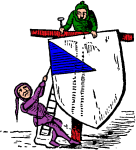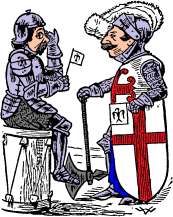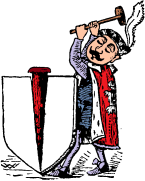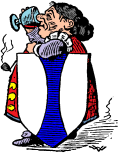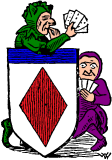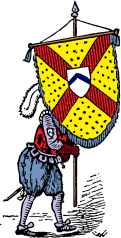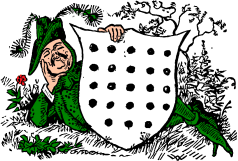HOME
Preface
Introduction
1
2
3
4
5
6
7
8
9
10
11
12
13
14
15
16
17
18
19
20
21
22
23
X
CHAPTER X.
OF SUB-ORDINARIES.
HE Sub-Ordinaries now claim our attention. These number in all fourteen, and, as they will form our present course, we will proceed to serve them up for the palates of our readers, making up by the sauce for the heaviness of the food. Heraldry is known to be a dry subject; so, on the homoeopathic principle that "like cures like," we will add a little chaff.
The first sub-ordinary we shall draw out and wave on our Heraldic banner is the "Gyron." This is formed by two lines, one drawn diagonally from one of the angles to the centre of the shield, meeting another straight line drawn from the same side : the whole giving us the idea that at first the inventor had intended to put a triangle into the escutcheon and had then thought better of it, and had only inserted half a one. When there are six, eight, or ten Gyrons in the field, the blazoning is said to be "gyronny," just on the principle that boys term a pudding with more than the usual amount of plums a "plummy pudding."
Next comes the "Quarter," which, as its name denotes, occupies a fourth of the shield, and always in the "dexter chief," or, to reduce the Heraldic jargon to the language of common life, in the right-hand upper corner.
It is a plain square, as once was that of Leicester, but which now, thanks to a Baronial Grant, though not in China, is quite a flowery land.
And on we go again to the "Canton," which has nothing to do with Switzerland ; so our readers need not fancy that any "Merry Swiss boy" business is here going to be transacted. It exactly resembles the Quarter, of which it may be said to be a little brother, as it only takes up one-fifth of the shield instead of one-fourth. It is supposed to represent the flag borne by knights bannerets, which was of small size, as those knights were created on the field of battle, where it was but natural the supply of bunting would run short, it being scarcely likely that a man would take some with him on the speculation that the cutting off the heads of his enemies would prove for him a short cut to glory.
Our next sub-ordinary is the "Fret," not that we intend to do so--quite the contrary. It is formed by two narrow bendlets, interlaced by a small square. Sometimes it is called the "Herald's true lover's knot," and we need scarcely mention the appropriateness of the connection between love and frets, which must, of course, be apparent to the meanest amorous capacity.
When the escutcheon is covered with these true lovers' knots, it is termed "fretty," and who would not be fretty at finding a number of such tokens in the possession of one party, especially if the belief had been cherished that only the knot of one beau, and that one yourself, had been preserved.
Fifthly comes the "Pile," which is in shape like a long narrow wedge, and must have been invented by a Herald of destructive proclivities trying to split a shield by driving a wedge therein, but failing and leaving the wedge in disgust, christened it an ordinary. It exactly represents a pile upon which bridges are built; nor can we be surprised at this, for Heralds invariably had an arch way with them.
To proceed, we have the "Orle," which may, of course, be all our fancy painted it, and a lot more besides, but is a kind of inner border within the shield. A good notion of this ordinary may be obtained by taking two hats, one a large size and the other considerably smaller, cutting off the brims and placing one within the other; flatten both to the required shape, and there you have the Orle. We should advise the experimentalist not, for obvious reasons, to use his own property for the trial.
After the Orle comes the "Tressure," a neat article of the same kind, but only half the width of that charge. When we have said that we have not, however, said everything thereanent. It is generally borne double, or one within the other; so that when a Herald had more than one, he was able to act on the advice given to unskilful horsemen, and make the Tressure get inside. The Tressure is ornamented with fleur de lys, that is to say those flowers are placed on the sides, reminding us somewhat of the sprigs of holly stuck about a Christmas pudding.
This bearing forms a part of the arms of Scotland; the legs of Scotland, especially the Highland legs, having a baring of a different kind, and as a rule gravitating towards England. It was granted by Charlemagne to Achaius, the then king of the country, as a present of honour. For our own part, we should prefer a present of game to any such unsubstantial gift, but in those times the smallest honorial donation was thankfully received and gratefully acknowledged.
The "Flanches" come next. They are formed by two curved lines nearly meeting in the centre of the escutcheon. To give a receipt for making them in the style of that mirror of cookery, Mrs. Glasse, we should say: first catch your shield--a plain one is best--on which no Heraldic cookery has been performed. Draw two circles, cut a slice off each and place at opposite sides within the shield. Serve up as wanted. Of this sub-ordinary there are two diminutives, "Flasques" and "Voiders." The former of these would seem to have some connection with drinking, and doubtless Heralds, like other men, had no objection to moisten their Heraldic clays. Voiders, again, clearly relate to the same subject; being smaller than flasques, may be taken to typify glasses when voider or emptier than they were when filled.
We now come to the "Lozenge," a sub-ordinary exactly represented by a jujube. Visions of anti-pertussents rise before us as we take this charge out of the Heraldic coffer. The Lozenge may be of any size, either filling up the whole of the shield, like two fat women in a small Hansom, or only just appearing at the corner of the shield, like one small passenger in a three-horse omnibus. When the shield is crossed by diagonal lines, it is called "lozengy," a good idea of which may be formed by thinking of the open-work jam tarts of childhood.
The "Fusil" is narrower and longer than the "Lozenge," and gives us the notion of a partially-sucked and pulled-out-length-ways lozenge. It is also called the "Spindle," from its supposed resemblance to that ancient housewifely instrument. Anyone who can see the resemblance is perfectly welcome to do so, though for our own part we shall not spin a yarn upon the subject, as we consider it needle-less. A fusil is also a light kind of gun, but we should not hit the mark if we imagined there was any connection between that weapon and the sub-ordinary in question.
In the "Rustre," our friend the jujube appears once more. Again referring to the Heraldic cookery book, we find the following directions: take a lozenge, punch a hole in the middle, place in centre of the shield, garnish with what you please, or serve up plain or according to taste. At least, if you don't, we have given you the means of making a very good substitute.
The "Mascle" derives its name from macula, the mesh of a net. Though the derivation is somewhat fishy, yet we hope our readers will not carp at our description. Still, if we should flounder at this place, our sole desire is to give a friendly lift or hoister to every man jack into the science of Heraldry. Not yet are we free of the Lozenge, for the Mascle is another connection of this cough-no-more ordinary. It is, however, a mere frame lozenge-shaped, or, as the Heralds would express it, a "lozenge voided." Our own ideas on the subject correspond exactly with the scientific description, for we have held, ever since the days of infancy, when peppermint specimens of the article invariably followed senna tea, that lozenges of all sorts are things specially to be avoided.
Next comes the "Inescutcheon." This is merely, as the name denotes, a small shield inside a larger one, and, like the result of many races, is a case of an outsider coming in.
We come now to the last sub-ordinary, the "Guttes," a name vulgarly and unpleasantly suggestive of the internal economy of the human and other bodies. Some Heralds do not class this charge among the sub-ordinaries at all, but we intend to be more liberal. The word is derived from "goutte," a drop, and we may at once state that it has no connection either with capital punishment, the Old Bailey, or Mr. Marwood.
Guttes are small round spots borne on the shield, and when they are placed at equal distances over the whole of the shield, giving it somewhat the appearance of having been suddenly taken ill with some cutaneous disorder, the cognizance is called "gutty."
As in common life there are drops of different kinds,--for instance, drops of comfort, drops of brandy, and drops in life,--so also in Heraldry Guttes or drops differ. When the Guttes are gold colour, the shield is said to be "gutty d'or." We should prefer, however, a bucketfull, or, why not say a hogshead while we are about it, instead of a few drops of gold. When white it is called "gutty d'eau," or water colour. This has a very washy sound, and calls to mind Sir Wilfrid Lawson and teetotallers, a class of people who ought to be the happiest in the world, since, according to their own accounts, they are never given to whine, which perhaps accounts for the unsteady gait of the sons of temperance after their annual festivals at the Crystal Palace and elsewhere.
When the drops are red, they are said to be de sang, or of blood, which suggests cut fingers, and sticking plaister that never sticks. When blue they are said to be de larmes, or of tears. This notion is too ridiculous. Who, beside a Herald, ever heard of blue tears? That people may look blue is possible : we ourselves have done so at times, notably when expecting a remittance from our country estate and receiving a County Court summons from our discontented tailor instead. But blue tears. Never!
When the "Guttes" are black, they are called de poix, or pea colour. Again we demur to this description. Mellow pears are all very well; green peas when young are like young ladies, nice;--peas-pudding not perhaps tempting, but decidedly cheap, and oh! so filling--all these we have heard of and even know; but black peas argue a degree of nastiness, not to say putridity, that would turn the stomach of a rhinoceros. We are really surprised at meeting with such unpleasantness among the Heralds.
Finally, when green, the "Guttes" are d'huile, or olive-oil colour. This definition clearly originated with some King-at-arms, who had a predominant taste for salad. Still, as we are strong, so will we be merciful, and he shall receive no dressing on that account. And this concludes the Sub-Ordinaries.
X
1
2
3
4
5
6
7
8
9
10
11
12
13
14
15
16
17
18
19
20
21
22
23
Preface
Introduction
HOME
Build: 2019/04/20 14:20:08.59+0900(JST)


